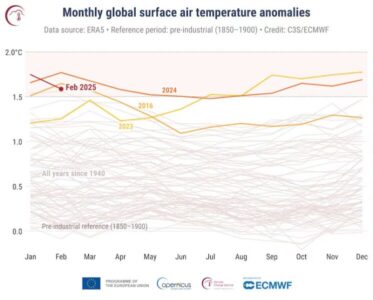The majority of companies around the world are unprepared for the risks caused by temperatures soaring due to climate change, a new report has revealed.
The study shows only slightly more than a third of firms, 35 per cent, have factored in a plan to adapt for climate change. The report, from market intelligence firm S&P Global Ratings, came as Arctic sea ice reached a record low in February, according to a report from Europe’s climate monitoring service, Copernicus.
It is the third consecutive month in which the level of sea ice extent, the name given to the area of ocean where there is at least some sea ice, has set a record low. The results are particularly concerning given that sea ice reflects sunlight back into space, playing a vital role in keeping the planet cool.

“Even under a medium climate change scenario, major companies face trillions of dollars in climate-related financial costs.” said Paul Munday, global climate adaptation and resilience specialist with S&P Global Ratings. “Yet relatively few are creating climate adaptation plans to soften the blow.”
Despite the potential financial cost of climate change, which it is estimated will reach $25 trillion by 2050, S&P’s report highlights that the lack of preparation poses a major risk to the global economy.
Temperatures rising
The latest findings come on the back of temperatures in January 2025 that topped previous records. Last month closely followed the trend as the third-warmest February in history globally, at 1.59°C above pre-industrial levels.
Scientists at Copernicus say this tips 19 of the last 20 months over 1.5°C above pre-industrial levels. The Paris Agreement, a legally binding international treaty on climate change, has as its main goal limiting temperature increases to 1.5°C above pre-industrial levels.
Samantha Burgess, strategic lead for climate at the European Centre for Medium-Range Weather Forecasts, said: “One of the consequences of a warmer world is melting sea ice, and the record or near-record low sea ice cover at both poles has pushed global sea ice cover to an all-time minimum.”
The average sea ice for February 2025 was at its lowest in the nearly 50 years that the data has been recorded, and about 8 per cent below the 1991–2020 average for February.
Earlier this year the World Meteorological Organisation (WMO) confirmed that 2024 had been the hottest year on record. This was followed by an unexpectedly hot January, with the La Nina weather pattern, which cools global temperatures, not enough to bring down rising temperatures.
At that time, Julien Nicolas, a climate scientist from Copernicus had said that the weather event could disappear completely by March. In an update on Thursday, scientists at WMO released an update that the weak La Nina event is expected to be “short-lived”, adding that the uncertainty over how coming months will trend is “higher than usual”.



